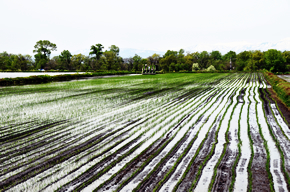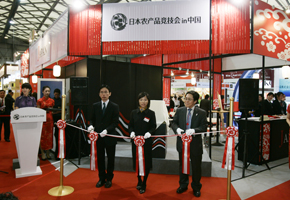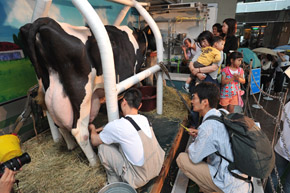
- Expertise
BtoB
Issue Management
Public Affairs
Campaign Summary
Japan’s dairy industry was in crisis. Squeezed by rising input costs yet unable to secure better prices for their milk, dairy farmers were abandoning the industry. Raw milk production fell by nearly 7% in a decade. The Japan Dairy Council asked PR Consulting Dentsu to help win public acceptance for Japan’s first wholesale milk price increase in 30 years. The subsequent campaign of educational activities targeting media, distributors and consumers gained wide understanding of the industry’s plight and successfully prepared the way for price rises in April 2008 and March 2009.
Statement of the Problem/Opportunity
Japanese retailers traditionally regarded milk as a “product to be discounted”, a loss-leader item to attract traffic to their supermarkets. Thus, the common belief among the public was that milk is always cheap. This perception was proving an insurmountable obstacle to attempts by the Japan Dairy Council (JDC) to gain acceptance for the milk price hike the dairy industry desperately wanted.
By 2007, the need to raise the price of milk was becoming critical. At home, low profitability was leading farmers to abandon dairying. By 2006 the number of dairy farms had plunged from a peak of 417,600 in 1963 to just 26,600. In the ten years to 2006, declining dairy herds led raw milk production to drop 6.6% or by approximately 570,000 tons. Partly to blame were soaring costs that farmers couldn’t meet. Feed, for example, constitutes 40% of dairy producer costs, and the increased use of corn for bioethanol production had seen corn feed prices surge by 1.5 times between 2006 and 2007.
Meanwhile overseas, Australia – a major exporter of milk – was struggling to make shipments because of a drought, and rapidly increasing demand for milk in China, India and other emerging markets was raising concerns in Japan of an impending international crisis.
The domestic milk shortage, compounded by difficulties securing imported milk products, led JDC to fear for the continued stable supply of milk and milk products. The first price change in 30 years could not be avoided, yet implacable resistance was almost inevitable. In August 2007, JDC sought the help of PR Consulting Dentsu(PRCD).
Research
PRCD’s first step was to conduct a media audit on the issue. Over a one-week period, four reporters from Asahi Shimbun, Mainichi Shimbun, Yomiuri Shimbun, (Japan’s most influential national dailies) and Japan Broadcasting Corporation, Japan’s sole public broadcaster were interviewed. This revealed that the media required:
- ・An easy-to-understand explanation of how grim the dairy farmers’ financial situation was
- ・An explanation of the milk pricing system
- ・Why milk prices could not be raised immediately when prices for flour, cooking oil and other daily necessities were raised
- ・Why milk prices could be raised abroad (such as the U.S. and Germany) but not in Japan
- ・Opinions/feelings of dairy farmers
The media audit showed that an action plan for Japanese dairy farms was necessary to generate media coverage. A key message would highlight the farmers’ plight through data detailing the decline in dairy farms and cattle herds, raw milk production, rising production costs including cattle feed, and changes in gross income.
Planning
- Strategy:
- PRCD believed that persuading JDC’s direct customers – the large dairy product manufacturers – to accept price increases would be difficult. After all, the Council had been lobbying them for years without success. Instead, PRCD decided that to gain leverage in pricing negotiations with retailers, JDC needed to show that the manufacturers’ target groups – retailers and general consumers – understood and supported the need for a price hike. Then, after gaining retailers’ support, JDC could persuade dairy product manufacturers to accept price rises.
- The approach called for balancing ‘hard’ and ‘soft’ campaigns.
- ‘Hard’ information had to be provided to consumer and industry media. To do this, PRCD organized media seminars – in October 2007, September 2008, and February 2009 – where press materials were distributed with information and numerical data presenting the Japan dairy industry’s predicament. The 2007 theme was “The present and future of Japanese dairying”; by 2008 as the situation worsened, the theme adopted was “The deepening crisis: the situation of Japanese dairying.” Over 170 press attended the seminars.
- Central to the success of each seminar was the role of a third-party adjudicator or influencer invited to discuss the Japanese dairy industry, compare overseas case studies, and talk about Japan’s unique distribution system. This gave a sense of the milk supply crisis from a variety of perspectives.
Based on PRCD’s advice, the Council obtained the support of KOL Nobuhiro Suzuki, professor of agricultural economics at the prestigious University of Tokyo. - At the seminars, dairy farmers also presented first-hand experiences, delivering emotionally-charged addresses that catalogued their losses, the decimation of their herds and the retreat of fellow-farmers and neighbors from dairying. These heartbreaking stories left an impression on journalists and helped them grasp the full seriousness of the situation.
- Meanwhile, the ‘soft’ side of the campaign saw PRCD mount street-side events in urban centers that allowed farmers to directly address consumers about the crisis and show the unity of the industry.
-
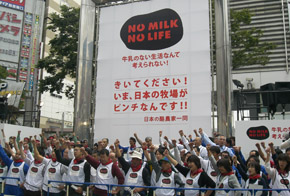
Dairy farmers gather at the street event
in ShinjukuIn October 2007, PRCD organized an event that brought dairy cows to Shinjuku, Tokyo’s busiest commuter hub. Sixty five dairy farmers and JDC staff from around Japan participated in the street-side event to raise awareness of the milk crisis with placards and distributed leaflets. The cows attracted the attention from passers-by and fueled enthusiastic debate in consumer media and on daytime TV. Concurrently, with the agency’s advice, another 85 farmers and JDC staff distributed 30,000 leaflets in the eight busiest areas of Tokyo including Ginza and Shibuya with placards.
- A similar event was held in the middle of Yurakucho, Tokyo’s central business and shopping district on June 1, 2008 to mark the UN Food and Agriculture Organization’s “World Milk Day” that featured cow-milking for schoolchildren and sampling of drinks using milk. Japan’s Minister of Agriculture, Forestry and Fisheries, Masatoshi Wakabayashi also attended and discussed the milk industry’s importance.
-
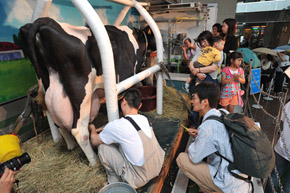
Children milking a cow
Believing that distribution was also key to increasing milk prices, PRCD organized a seminar for retail buyers co-sponsored with influential Chain Store Age magazine. Besides illustrating the milk supply crisis, PRCD used the seminar to highlight a case study of collaboration with a milk company to help sales. Based on PRCD’s advice, the Council contacted and selected academics including a prominent professor from Gakushuin University and a specialist of pricing strategy to discuss formulating appropriate prices for milk. Shinya Arai, the All Japan Supermarket Association chairman, was also invited. The milk pricing discussion was extensively reported in Chain Store Age magazine.
Campaign Outcomes/Monitoring and Evaluation
- Media exposure: Newspapers – 96, TV – 262
- Media impressions: 2,519,106,541
- Ad value:JPY11,677,369,410
- ・March 2008 – Japan’s wholesale milk price was raised for the first time in 30 years by 3 yen per kg.
- ・April 2009 – The wholesale milk price was raised by a further 10 yen per kg – the full amount JDC desired.
受賞歴
- 12th Public Relations Society of Japan Awards
2009Category winner
- PR WEEK Awards Asia
2009Campaign of the year
2009Business-to-business campaign
2009Public affairs campaign
- IPRA Golden World Awards for Excellence
2009Category: “Business-to-business”


